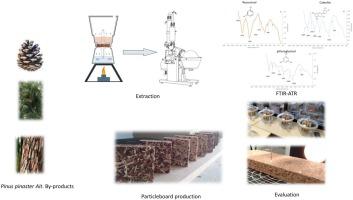Industrial Crops and Products ( IF 5.6 ) Pub Date : 2021-04-30 , DOI: 10.1016/j.indcrop.2021.113581 J. Santos , J. Pereira , N. Ferreira , N. Paiva , J. Ferra , F.D. Magalhães , J.M. Martins , Y. Dulyanska , L.H. Carvalho

|
Maritime pine (Pinus pinaster, Ait.) is one of the most important trees in the Iberian Peninsula forest. Its wood is mainly used in the wood-based panels production and for pulp and paper factories. The aim of this work was the valorisation of the main forest by-products of the P. Pinaster: bark, pinecones and needles. These organic by-products were widely used in small rural farms, but nowadays are mostly left in the forest, contributing to the forest fires problem. P. pinaster by-products were evaluated bearing in mind its wettability and chemical composition (evaluated by FTIR-ATR). Extracts were obtained from the bark, pinecones, and needles using a steam pressure extraction method (2% NaOH)”, a simple extraction method used for the first time in the valorisation of biomass for its application in biomaterials. The structures of resorcinol, catechin and phloroglucinol appear in pine needles, pinecones and bark extracts, respectively. Extracts self-condensation curing process was evaluated by differential scanning calorimetry, and an automatic bonding evaluation system. For the first time particleboards were manufactured at a specific pressure of 4 MPa and 190 °C of press temperature for 3 min, with different percentages of the three maritime pine by-products, using a melamine-urea-formaldehyde resin and citric acid as particle binder. Due to the fast reactivity between polyphenols and formaldehyde, the influence of each by-product on the formaldehyde emission was also studied. The results show that it is possible to improve water resistance and internal bonding strength, and to control formaldehyde emission of particleboards, by using underutilized Maritime pine-based by-products in particleboards, replacing wood particles up to 20 % by weight.
中文翻译:

海松(Pinus pinaster,Ait)的非木材副产品的价值评估,用于刨花板生产
海上松(Pinus pinaster,Ait。)是伊比利亚半岛森林中最重要的树木之一。它的木材主要用于人造板生产以及纸浆和造纸厂。这项工作的目的是对P. Pinaster的主要森林副产品:树皮,松果和针叶进行增值。这些有机副产品被广泛用于小型农村农场,但如今大部分遗留在森林中,加剧了森林大火的问题。松果考虑到其副产物的润湿性和化学组成(通过FTIR-ATR进行评估),对副产物进行了评估。提取物是使用蒸汽压力提取法(2%NaOH)从树皮,松果和针头中提取得到的,这是一种简单的提取方法,首次用于生物质的增值,并将其应用于生物材料中。间苯二酚,儿茶素和间苯三酚的结构分别出现在松针,松果和树皮提取物中。通过差示扫描量热法和自动粘合评估系统对萃取物的自凝结固化过程进行评估。首次以4 MPa的特定压力和190°C的压榨温度制造刨花板3分钟,其中三种海洋松木副产品的百分比不同,使用三聚氰胺-脲-甲醛树脂和柠檬酸作为颗粒粘合剂。由于多酚和甲醛之间的快速反应性,还研究了每种副产物对甲醛释放的影响。结果表明,通过在刨花板中使用未充分利用的海上松木副产品,代替重量百分比最高为20%的木材颗粒,可以提高刨花板的耐水性和内部粘合强度,并控制甲醛的释放。











































 京公网安备 11010802027423号
京公网安备 11010802027423号